Mango Pickle Recipe (With Mustard Oil)
Mango Pickle (also called Aam ka Achar) is a traditional Indian condiment made from green, raw, unripe mangoes that are preserved with a blend of spices, salt, and oil. Here’s a Punjabi Mango Pickle that’s authentically our family heirloom recipe and brimming with robust flavors. This Mango Pickle recipe which is zingy, zesty and tangy makes for the tastiest accompaniment with any Indian meal because of the choicest of spices that are used to make it. So, this summertime, pick the good green mangoes, prep up and go for this pickle recipe.
About Mango Pickle Recipe
Essentially a mango pickle recipe is made with tangy unripe green mangoes, spices, salt and oil. It is a popular accompaniment in Indian cuisine and is known for its bold, tangy, spicy, and sometimes slightly sweet flavor, depending on regional and local variations.
Besides being the most apt choice for stuffed paratha, dal and rice or any other rich Indian gravy in a rice or bread combination, this Aam Ka Achar is well received not just by Indians, but also people around the world.
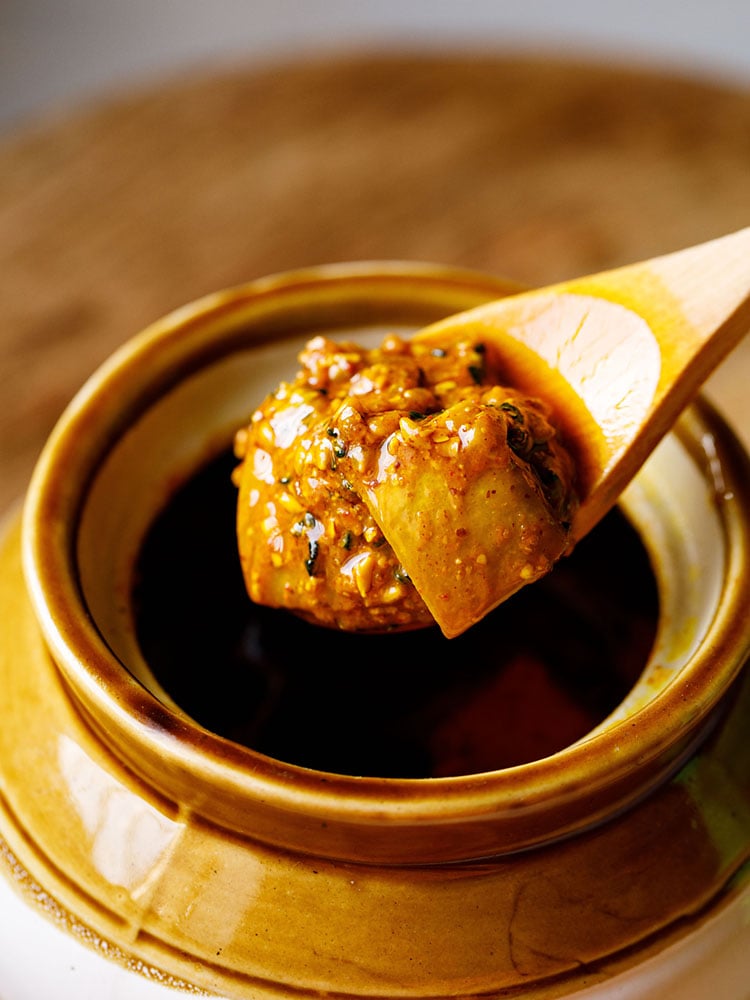
This is why this particular mango pickle is a sure shot hit!
- It is super easy to make. All you have to do is mix up the mango pieces with salt, spices and put it in lots of sunshine for 3 to 4 days.
- Next, you just pour good quality mustard oil and keep the jar safely in a cool, dry place for another 3 to 4 days.
- By this time, it’s ready for you to indulge in!
This Punjabi Mango Pickle recipe is my mother-in-law’s special. She had learnt it as it passed down from her mother-in-law. We Indians really take pride in such valuable recipes that are nothing less than a treasure.
There are numerous ways an Aam Ka Achar is made pan India with each pickle having a distinct flavor and method of preparation.
As you travel through our country’s length and breadth, you will find people pickling raw mangoes, in both sour and sweet versions and enjoying them with their everyday meals.
I am quite a pickle person and like to pair everything from dal, vegetable stir-fries, roti and paratha with a variety of pickles.
If you love pickles just as I do, I’m so sure that you are going to fall in love with this Mango Pickle.
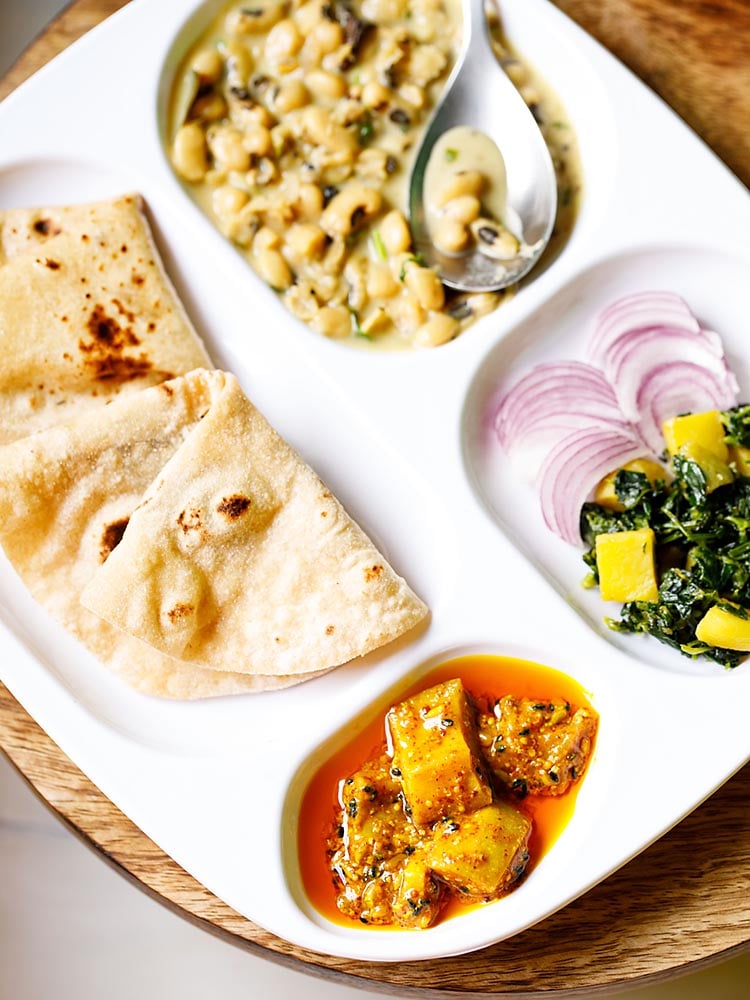
How to make Mango Pickle
Prepare Spices
1. Before you begin, take the spices and salt in small bowls and keep them in sunlight for 1 to 2 hours. This step is optional but does help in getting rid of any moisture from the spices and salt.
Spices added to this pickle recipe are:
- Fenugreek seeds – ¼ cup
- Fennel seeds – ¼ cup
- Mustard seeds (can use either black or yellow) – ¼ cup
- Nigella seeds (kalonji) – ¼ cup
- Turmeric powder (ground turmeric) – 3 tablespoons
- Red chili powder or cayenne pepper – ¼ cup
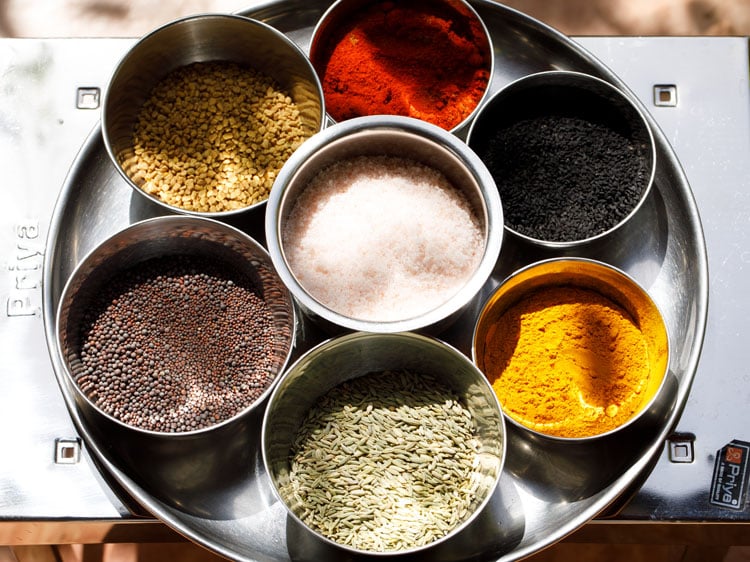
2. Later, take the fenugreek seeds and mustard seeds in a dry grinder jar or a spice-grinder.
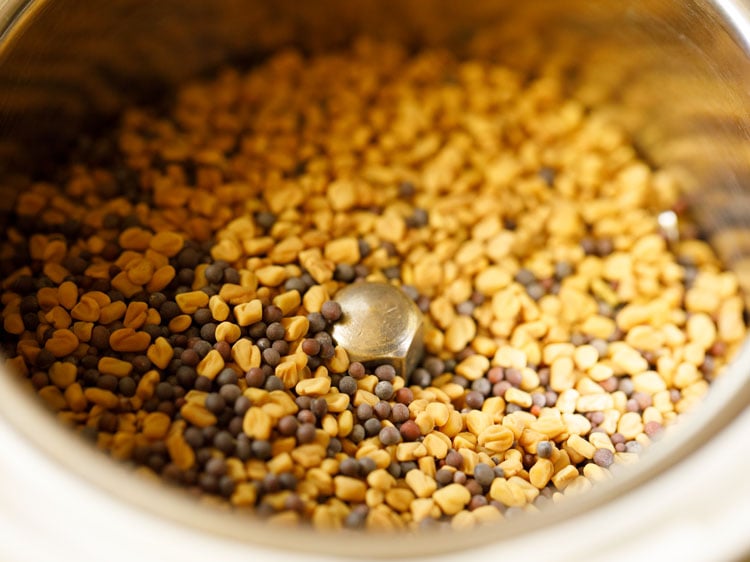
3. Grind to a coarse mixture. Do not make a fine powder.
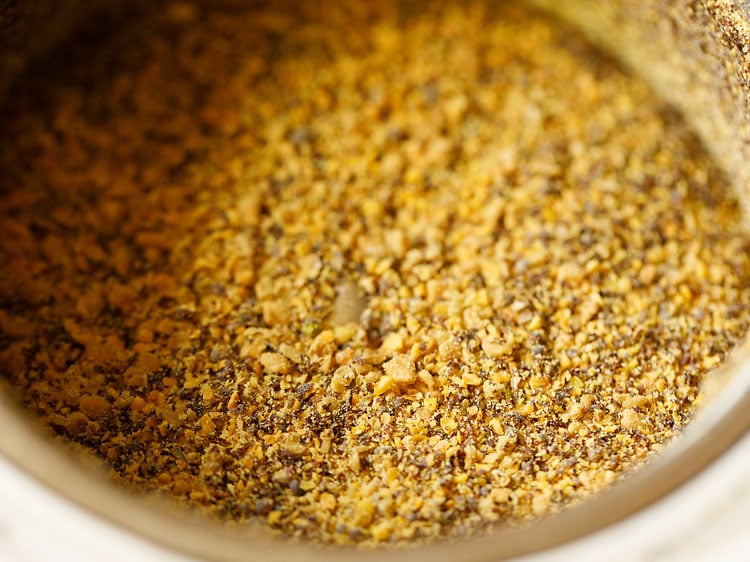
Prepare Mangoes
4. Rinse and wipe the raw mangoes well with a clean kitchen towel. You can even let the mangoes dry naturally.
In the photo you only see two mangoes as they were very large mangoes weighing 1 kilogram together.

5. Chop the mangoes into 1.5 inches pieces. Discard the stones but do peel off the flesh from the stones, if any.
No need to remove the outer skin of the mangoes if they are tender and soft. You will need 7 to 7.5 cups chopped mangoes.
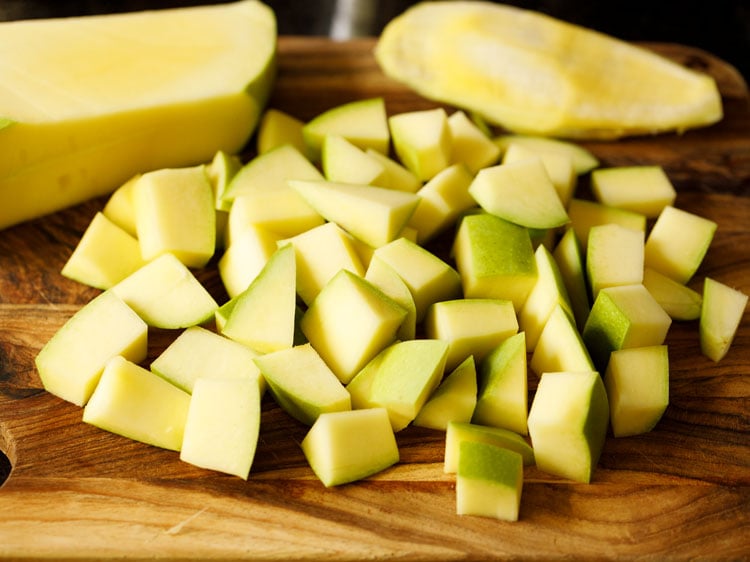
6. Take the chopped mangoes in a large mixing bowl. Better to use a steel or a glass bowl as they are non-reactive.
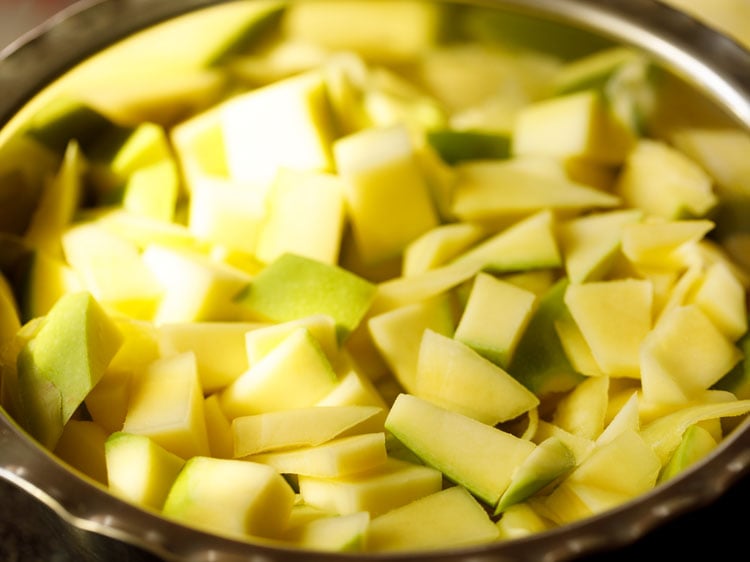
Make Pickle Masala Mixture
7. Now firstly, add the ground fenugreek seeds and mustard seeds.
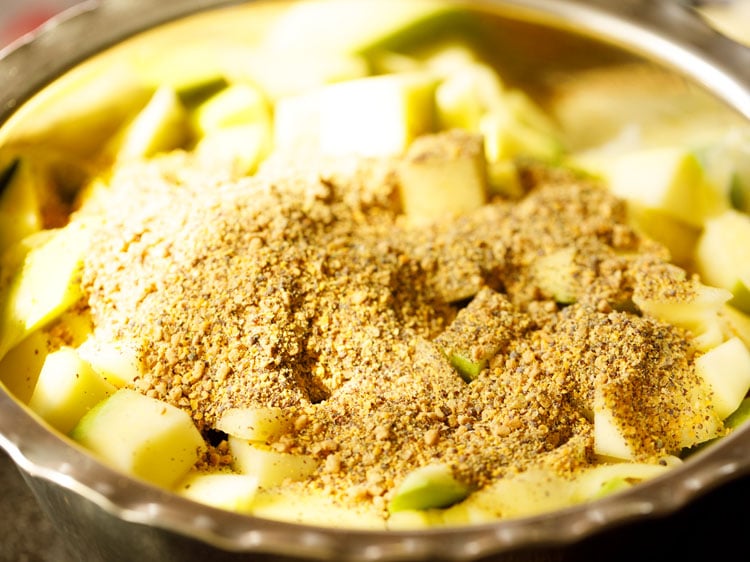
8. Then, add the remaining spices – fennel seeds, nigella seeds, turmeric powder and red chili powder or cayenne pepper.
I have added two types of red chili powder – Kashmiri red chili powder (for color) and a spicy red chili powder.
You can use even just one type of red chili powder or even a mix of cayenne pepper and paprika.
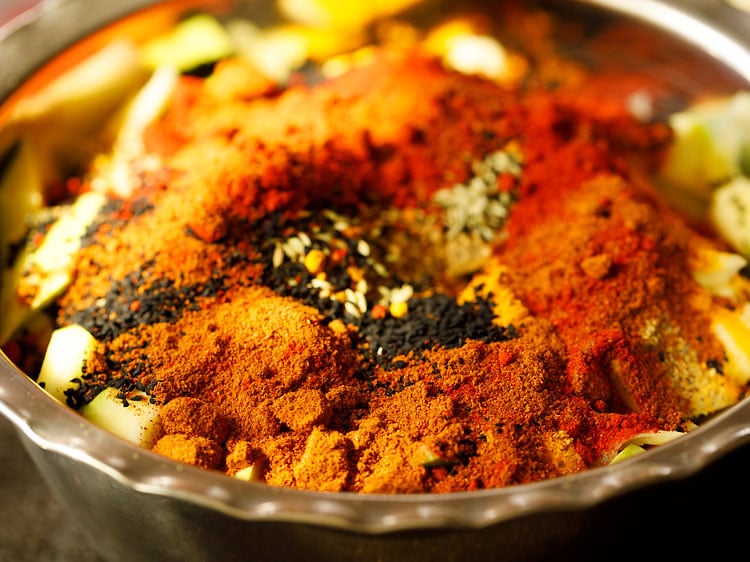
9. Next, add salt.
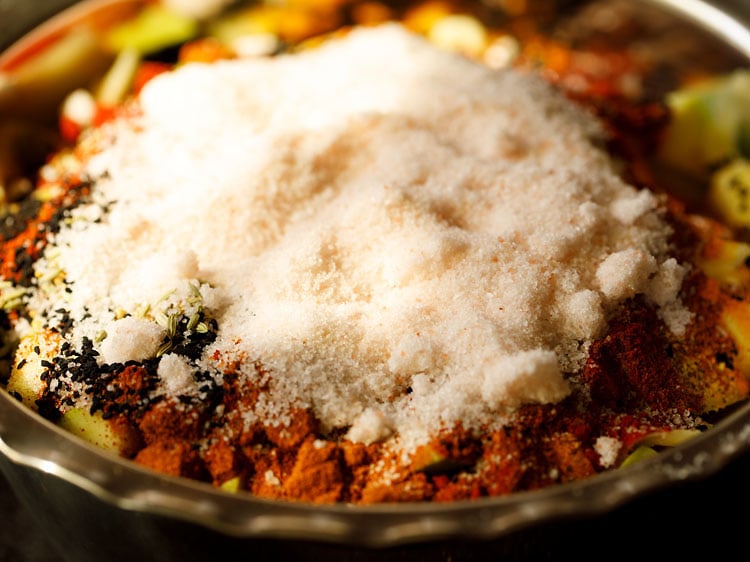
10. With a steel or wooden spoon, mix very well so that the spices uniformly coat the mango pieces.
Check the taste of the pickle masala mixture or 1 to 2 mango pieces. The taste should be slightly salty. If not, then add more salt.
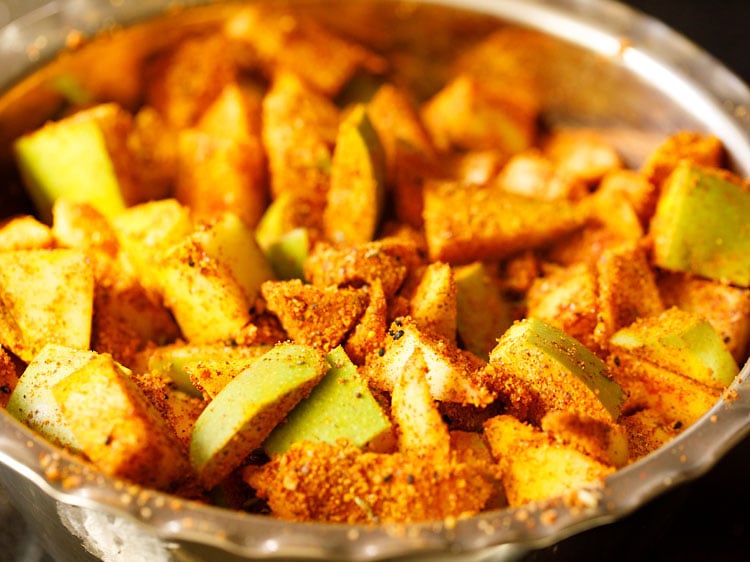
11. Now, pour ½ cup mustard oil.
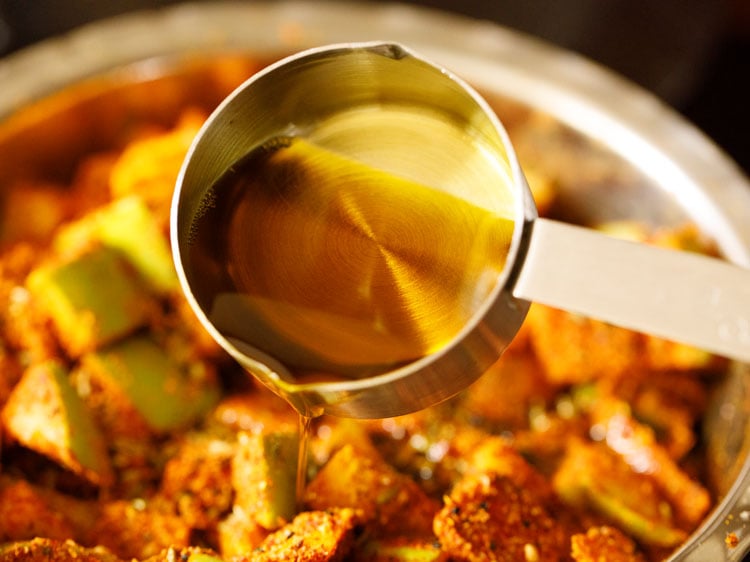
12. Mix very well.
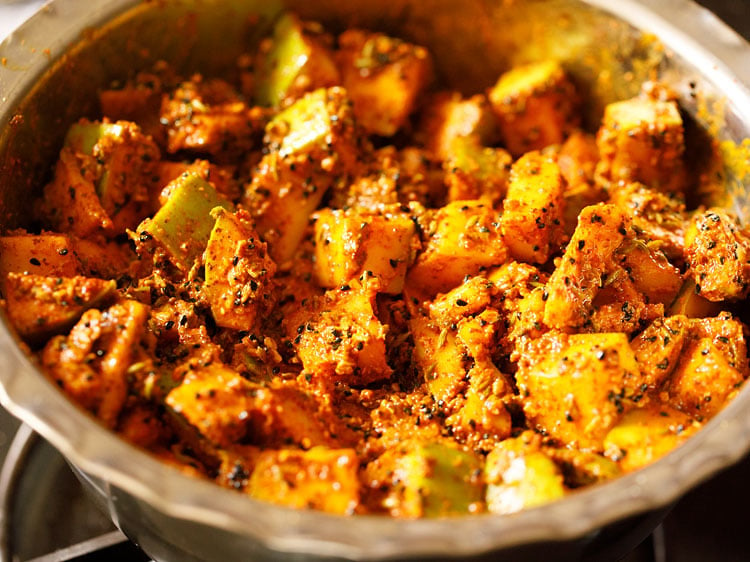
13. Spoon the prepared pickle mixture in a clean ceramic jar or glass jar. Use a clean spoon.
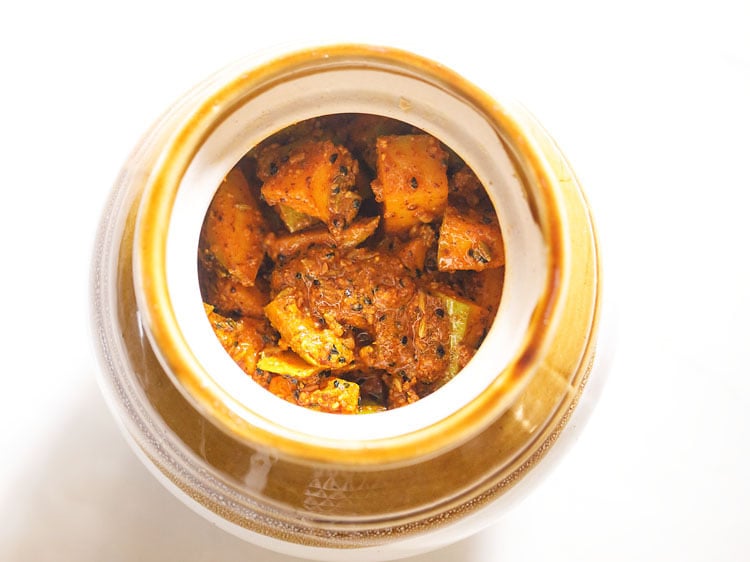
Make Mango Pickle
14. Seal with a lid and keep in sunlight for 3 to 4 days. I used two jars. Note that the sunlight should be very good with strong sun rays falling on the pickle jar.
It should not be cloudy or dark. In the evening, get the jar inside and keep in a cool dry place. Next morning, keep in sunlight again.
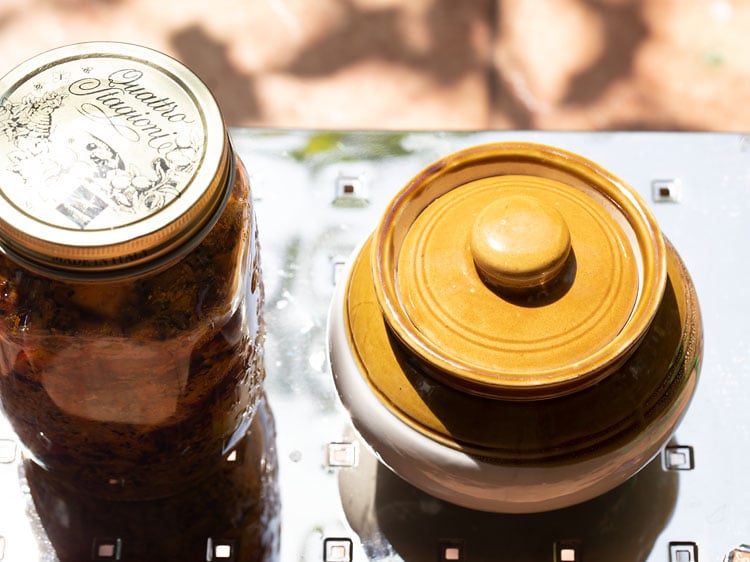
15. Everyday after sun-drying in the evening, open the lid and give a gentle mix to the pickle with a clean spoon.
This is the pickle being mixed on the first day. Take the mango pieces settled at the bottom upwards in the jar and give a thorough mix.
Basically, mixing and tossing needs to be done everyday.
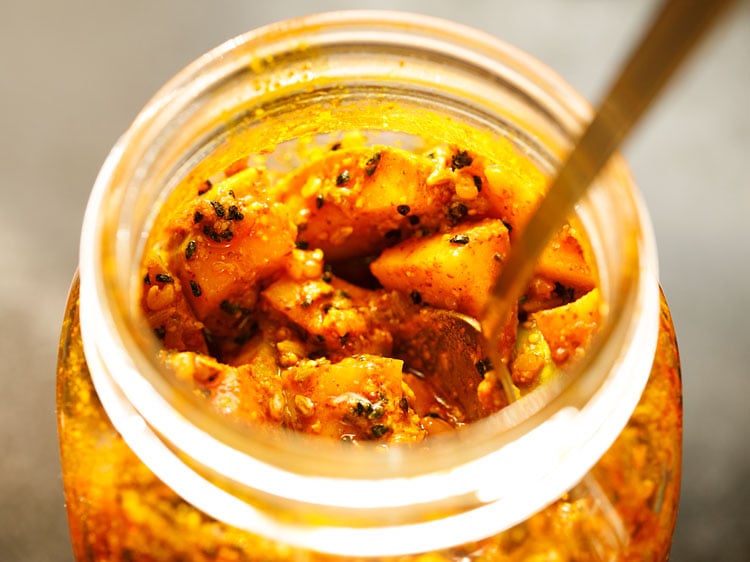
16. The below photo is of the pickle on the third day. You can see the oil floating.
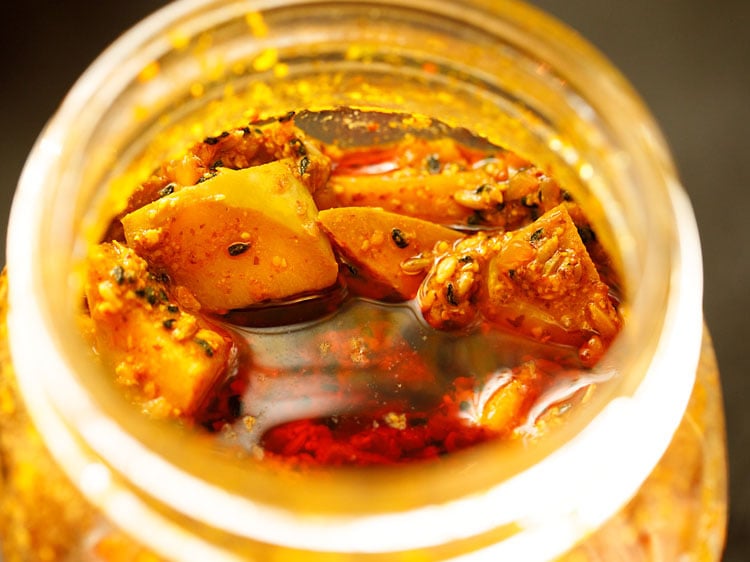
17. The pickle after mixing on the fourth day.
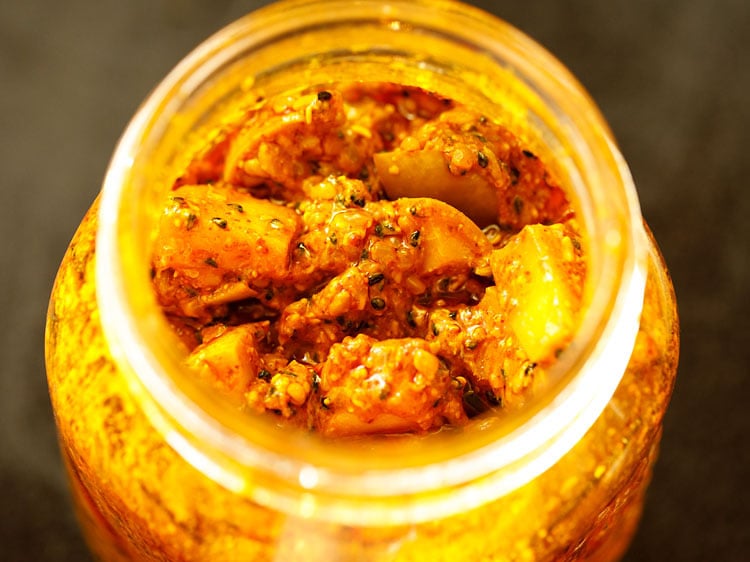
18. On the last day, pour 2.5 cups of mustard oil in the jar.
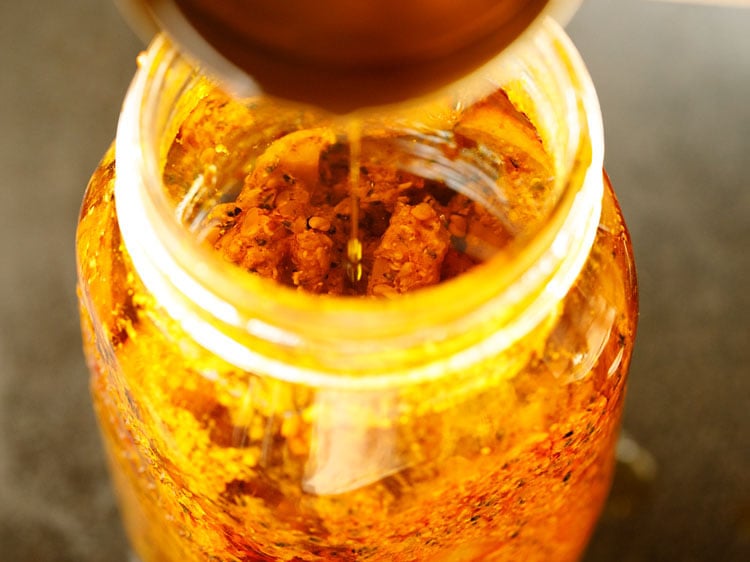
19. Again with a clean spoon give a thorough mix. The oil should seep inside and reach the bottom of the jar. All the mango pieces should be surrounded with some oil.
You do not need to heat the mustard oil. You can add more mustard oil if required. The mustard oil should float above the pickle by 2 to 3 inches. Always remember to keep the oil floating above the pickle.
Seal with a lid and keep in a cool dry place for 4 days until everything gets mellowed and pickled.
Initially, you may find a slight bitter taste in the pickle, but after 6 to 7 days, the bitterness will go away.
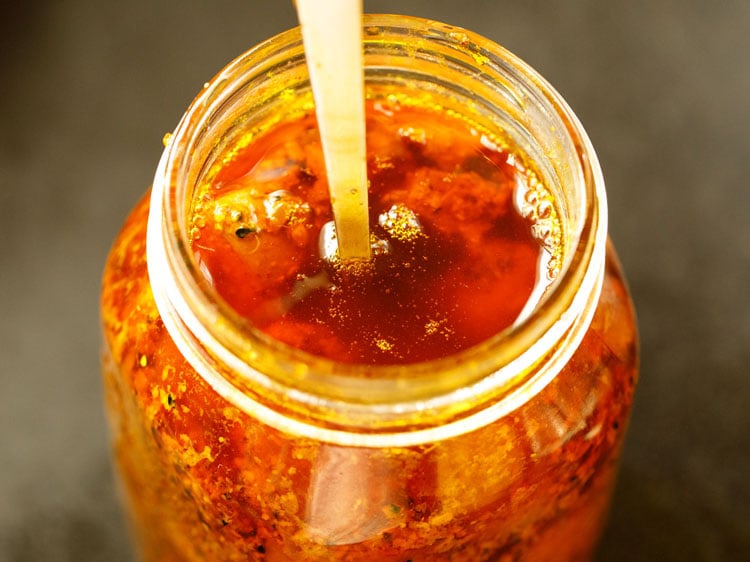
20. Enjoy the Mango Pickle or Aam ka Achar with any Indian meal.
The pickle stays good for more than a year at room temperature without refrigeration. Keep the jar in a cool dry place.
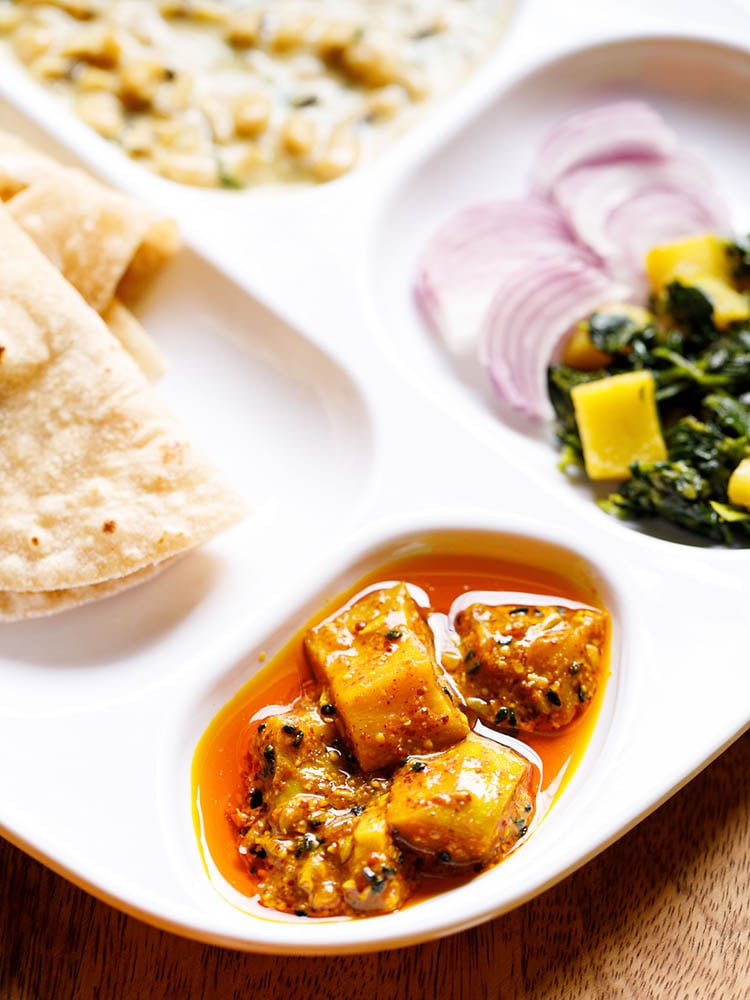
Serving & Storage Suggestions
Remember to store the pickle jar in a cool dry place. To serve, I would suggest to take a small portion of the pickle for a week or 15 days in smaller jars or bowls. Keep this jar or bowl on your dining table, kitchen or in the fridge.
While taking the pickle from the jars, always use a clean dry spoon. Make sure there is no water or moisture on the spoon as this can spoil your pickle.
In North India, apart from the usual way of consuming the Mango Pickle with meals, it is also served with flatbreads like Aloo Paratha, Paneer Paratha or any other paratha for that matter.
One of the most favorite childhood memories of ours includes we taking parathas with Aam Ka Achar in our lunch box.
When speaking of being a side condiment, the Mango Pickle tastes excellent with some rice-lentils, Curd Rice or other curries with rice.
This Punjabi Mango Pickle can also easily elevate a simple meal of even chapati or roti with any vegetable dish. Otherwise, mix the pickle masala with steamed rice and enjoy a simple and comforting, yet heavenly meal.
And while you lose yourself to the awesomeness of the sour Mango Pickle, this Avakaya Pickle is another recipe that you must try till the mango season lasts.
Make Pickle Without Sunlight
While it is absolutely paramount to have sunlight to make any traditional pickle, I have worked on a Punjabi Mango Pickle recipe that can be made sans the sun too.
You simply have to mix everything and pour it in a jar. But, do these before:
- Heat mustard oil till it smokes, and then cool it to room temperature. Add to the spiced mango pieces mixture.
- Make it a practice to cover this pickle with 2 to 3 inches layer of mustard oil on top in the jar.
- Close the lid of the jars tightly. Keep the jars in a dry place for about 5 to 6 days or more until the mangoes soften and tenderize.
- Do remember to stir the pickle with a dry and clean spoon once every day. Cover the jar again with a lid and continue to store it in a dry place until the pickle is ready.
Expert Tips
- Mangoes: Get raw mangoes with tender skin and use without peeling the skin. In case the mangoes have tough skin, then peel and use.
- Spices: Make sure to always use fresh spices. Take them on a plate and then discard the husks and stones, if any.
- Grinding Spices: Grind the mustard and fenugreek seeds coarsely for this pickle. You can also use store-brought split mustard and fenugreek seeds.
- Adjusting Spice Levels: You can add more or less red chili powder depending upon the level of spiciness you want in the pickle.
- Kind of Jar: The jar used to store the mango pickle should be thoroughly sterilized, cleaned and dried. Preferably use a glass jar or ceramic jar. Do not use plastic jars.
- Hygiene: Keep in mind the hygiene and cleanliness while making any pickle, jam, sauce, preserve or for that matter any food.
- Scaling: This Aam Ka Achar recipe can be scaled easily to make for smaller or larger batch.
India – The Pickle Nation
When one mentions India, one has to also mention about the plethora of pickles that the Indians are fond of.
The Mango Pickle being one of the most loved ones, followed by Lemon Pickle, Amla Pickle, Red Chilli Pickle and other versions made with seasonal fruits and veggies.
Just like how curries or samosa is synonymous with India, so is pickles. In fact, an Indian thali (platter) is quite incomplete without a portion of pickle in it, and it can be rightly termed as one of the most favorite condiments here.
Pickles pan India are found under different monikers. For instance, ‘achaar’ in Hindi, ‘oorugai’ in Tamil, ‘loncha’ in Marathi, ‘athanu’ in Gujarati, etc.
It is one of those foods that help in clearing the palate in between dishes and can elevate an otherwise boring meal.
Although the origin of the word pickle lies in the Dutch word ‘pekel’ meaning ‘brine,’ the ‘achaar’ has its origin in a Persian term meaning ‘fruits or vegetables which are salted/powdered and preserved in a solution of vinegar, salt, syrup or honey.’
Common Questions for Beginners
1. What do I do if the mangoes are still hard after pickling?
One way to soften the mangoes is just heating through, but not boil. Once the pickle is hot, let it cool on its own and don’t cover with a lid. However, you can cover with a pan, cotton napkin or muslin cloth. Make sure the water doesn’t condense as this might spoil the pickle.
2. How to choose mangoes for making this pickle?
Choose mangoes that are raw, firm and a dark green in color with a white-colored flesh. If the flesh is yellow, it means the mango is slightly ripe.
3. Do I use yellow or black mustard seeds for this pickle?
Use either. Both work well in this pickle recipe.
4. I kept the pickle for 7 days in sunlight without oil. Still, it caught fungus. Why and how do I rectify it?
Moisture in the pickle will result in fungus. Avoid this by covering the pickle with a thick layer of oil and keeping it dry. Any mould or fungus means you have to discard the entire pickle and there is nothing you can do to rectify it.
5. Can this pickle be dried under the fan?
Preferably, the pickle has to be sun-dried. If not, then it can be dried under the fan too. But this will reduce the shelf-life as otherwise sun rays kill microorganisms.
6. Should I throw the water that drains from the mango pieces after mixing the spices with them?
You needn’t discard the water as it gets evaporated while the pickle is sun-dried.
FAQs
Can I store this pickle in a plastic jar?
I would suggest not to store this mango pickle in a plastic jar. Try to use a ceramic jar or a good sturdy glass jar.
For how long this pickle stays good?
This mango pickle will stay good for more than a year. Even if the pickle is not sun-dried or partially sun-dried, it stays good for more than a year. Cover the pickle with a generous layer of oil as well to keep it good.
What is the best way to store this pickle in a barni jar?
Store this pickle in a ceramic jar by putting a muslin cloth on the mouth, later securing it with a string and then putting the lid.
Which oil can I use instead of mustard oil in this pickle?
You can prepare this pickle with sesame oil or sunflower oil.
Step by Step Photo Guide Above
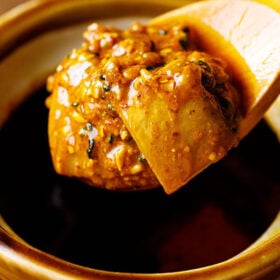
Mango Pickle Recipe (With Mustard Oil)
Ingredients
- 1 kilogram mangoes or 7 to 7.5 cups of chopped mangoes – unripe and green
- ¼ cup (40 grams) mustard seeds – black or yellow or split yellow mustard seeds
- ¼ cup (45 grams) fenugreek seeds or split fenugreek seeds
- ¼ cup (30 grams) fennel seeds
- ¼ cup (30 grams) nigella seeds (kalonji)
- 3 tablespoons (15 grams) turmeric powder (ground turmeric)
- ¼ cup (25 grams) Red Chili Powder or cayenne pepper
- ½ cup (125 grams) rock salt – edible and food grade, add as required; can also add regular salt or pink salt
- 3 cups mustard oil – add more if required
Instructions
Prepare Spices and Mangoes
- Before you begin, take the spices and salt in small bowls and keep them in sunlight for 1 to 2 hours. This step is optional but does help in getting rid of any moisture from the spices and salt.
- Later, take the fenugreek seeds and mustard seeds in a dry grinder jar or a spice-grinder and grind to a coarse mixture.
- Rinse and wipe the raw mangoes and let them dry naturally. You can even wipe them dry with a clean kitchen towel.
Making Pickle Masala Mixture
- Chop the mangoes into 1.5 inches pieces. and add them in a bowl. Discard the stones but do peel off the flesh from the stones, if any. No need to remove the outer skin of the mangoes if they are soft and tender.
- Take the chopped mangoes in a large non-reactive mixing bowl.
- Now begin by adding the ground fenugreek seeds and mustard seeds first.
- Then, add fennel seeds, nigella seeds or onion seeds, turmeric powder, red chili powder and salt.
- With a steel or wooden spoon, mix very well so that the spices uniformly coat the mango pieces. Check the taste of the pickle masala mixture or 1 to 2 mango pieces. The taste should be slightly salty. If not, then add some more salt.
- Next pour ½ cup mustard oil and mix very well.
- Spoon the prepared pickle mixture in a clean ceramic jar or glass jar. Use a clean spoon.
Making Mango Pickle
- Cover with a lid and keep in sunlight for 3 to 4 days.Note that the sunlight should be very good with the strong rays falling on the pickle jar. It should not be cloudy or dark.
- Everyday after sun-drying in the evening, open the lid and give a gentle mix to the pickle with a clean spoon. Take the mango pieces settled at the bottom upwards in the jar and give a thorough mix. Basically, mixing and tossing needs to be done everyday.
- In the evening, get the jar inside and keep in a cool dry place. Next morning, keep in the sunlight again.
- After keeping in sunlight for 3 to 4 days, add the remaining 2.5 cups mustard oil. Again with a clean spoon, mix very well. The oil should seep inside and reach the bottom of the jar. All the mango pieces should be surrounded with some oil.
- You can add more mustard oil if required.Note that you do not need to heat the mustard oil.Do keep in mind that the mustard oil should float above the pickle by 2 to 3 inches. Always remember to keep the oil floating above the pickle.
- Seal tightly with a lid, keep in a cool dry place for 4 days until everything gets mellowed and pickled.
- Initially, you may find a slight bitter taste in the pickle, but after 6 to 7 days, the bitterness will go away.
Storage Suggestions
- This Mango Pickle stays good for more than a year at room temperature without refrigeration.
- Store the mango pickle in a clean, dry, sterilized glass or ceramic jar. Always ensure a layer of oil floats above the pickle to preserve it.
- Once opened, use a clean, dry spoon and seal tightly after each use.
- I recommend to take a small portion of the pickle for a week or 15 to 20 days in smaller jars or bowls. Keep this jar or bowl on your dining table, kitchen or in the fridge.
Serving Suggestions
- Enjoy this Punjabi Mango Pickle with any Indian meal.
- Serve the Mango Pickle as a flavorful side condiment with dal-rice, khichdi, curd rice, paratha, thepla, poori, or even with plain steamed rice or a vegetable pulao.
- It also pairs well with stuffed parathas, upma, and simple Indian thalis.
Notes
- Make sure the spices are within their shelf period and have not gone rancid.
- Use good quality mustard oil and preferably cold pressed or wood pressed.
- Instead of mustard oil, you can use sesame oil (made from raw sesame seeds) and sunflower oil. But keep in mind that the taste and flavor of the mango pickle made with either of these oils will be different.
- If using sunflower oil, lightly heat it first and then cool it at room temperature before adding.
- Note that the approximate nutrition info is for the entire jar of Mango Pickle.
Nutrition
Mango Pickle recipe from the archives was first published on May 2012.

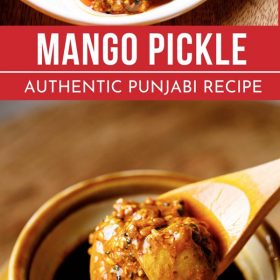
Hi if using sunflower oil should we heat oil or add the oil directly in the pickle
Sunflower oil won’t give the same taste and flavor as mustard oil. I suggest you to add mustard oil if you can get it.
But if you cannot, then lightly heat the sunflower oil. Let it cool completely and than add.
So easy to follow and that nutrition information was so detailed ⭐️⭐️⭐️⭐️
Hi Dassana,
Thank you for the recipe. Looks interesting. What if we want a sweet verison of the same recipe using Gud? How can we do that? can the raw gud be added to the mixture?
Thank you
Indija
The sweet version is made differently and the proportions of the ingredients will be different. Raw jaggery can be added to this pickle too but the rest of the ingredient proportions will change. Hope this helps.
Hi Dassana, thank you for this recipe. I will definitely give it a try.
Can you tell me, in your method WITHOUT USING SUNLIGHT, after step 2, do I cover the jars with the lid and then store it in a dry place, or leave it uncovered during this time?
Thank you and regards
Ga
Welcome Gav. Firstly make sure the oil floats at least 2 to 3 inches above the top surface of the pickle. Close the jars tightly and keep them in a dry place for about 5 to 6 days or as needed until the mangoes soften and become tender. Do remember to stir the pickle with a clean, dry spoon once every day. Cover again with a lid and continue to store until the mangoes are tenderized.
I want to learn from good ,original people from India !
Indian food.
This is delicious and very healthy..
Thank you very much.
Hello ma’m…thanks for sharing. I love the mango pickle that is served in most restaurants. Pickle from Mother’s Recipe also has the same taste as restaurants. Could you share the recipe of that type of mango pickle please…
Welcome Priyangi. Yes I know. Even we are fond of that pickle. I have ever made that type of pickle. If in the mango season I make this type of pickle, then I will share the recipe.
Excellent demonstration of recipe
Thanks.
Can I add some Amchur (Dry Mango) since my mangoes are not very sour. They were a bit Pale yellow but not ripe when I cut it.
Yes you can add.
Awesome and easy to follow..made achar for the first time using your recipe..thanks for sharing and giving me confidence to make achar..
Great to know and thanks for sharing the lovely feedback.
I tried to make the pickle very first time and it turned out to be so amazing that people are actually ready to pay me for making the same pickle for them.
Thanks a lot for sharing this simple and perfect recipe.
I have been following your recipes since last 4-5 years. And they are delicious every single time
Lots of love.
That is good to know and thanks for sharing your experience. Thanks also for the feedback on the other recipes. Glad to know and thanks again.
Thank you very much Meenu for the feedback and the kind wishes. You too stay safe and take care.
I’ve often thought that the heat of the sun in India was key to making Indian pickles safe to eat. It seemed like the sun pasteurizes the pickles. Thank you for adding that insight into the process. In the USA, many people have crock-pots for slow cooking. I wonder if crock-pots could be used in place of the sun for making Indian pickles.
thanks tim and welcome. i am not sure about using crock-pots for making pickles, but i have dried vegetables and fruits in the oven and it worked so well. the results were similar to the vegetables or fruits dried in the sun. perhaps slow drying in oven for pickles can work too. though i have not tried drying pickles in the oven.
I love the recipes you’ve uploaded, it helped me a lot in difficult situations…..I m thankful to you specially for aam ka achar, kachori , dhokla etc.
Thank you and nice to know.
Hi
I have just made this mango pickle. You mention it lasts for a year when sun dried. How long does it last if not sun dried or only partially sun dried?
if not sun dried or partially sun dried then also it can last for a year. just make sure that the pickle is nicely covered with a layer of oil.